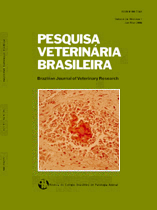 |
|
|
|
Year 2013 - Volume 33, Number 3
|

|
Productive systems of dairy goats in the semiarid of Paraiba: characterization, major limiting factors and evaluation of intervention strategies, 33(3):345-352
|
ABSTRACT.- Riet-Correa B., Simões S.V.D., Pereira Filho J.M., Azevedo S.S.A., Melo D.B., Batista J.A., Miranda Neto E.G. & Riet-Correa F. 2013. [Productive systems of dairy goats in the semiarid of Paraiba: characterization, major limiting factors and evaluation of intervention strategies.] Sistemas produtivos de caprinocultura leiteira no semiárido paraibano: caracterização, principais limitantes e avaliação de estratégias de intervenção. Pesquisa Veterinária Brasileira 33(3):345-352. Hospital Veterinário, Universidade Federal de Campina Grande, Av. Universitária s/n, Patos, PB 58700-970, Brazil. E-mail: saravilar@bol.com.br
Through a multidisciplinary study, eight dairy goat farms from the semiarid of Paraíba were studied for a period of two years with the aim to identify the main limiting factors for milk production and to propose and evaluate intervention strategies. A questionnaire was used to obtain information about the farms and their herd management. The forage availabilities were evaluated and proposals were made for correction. The animals were identified to facilitate the zootechnical bookkeeping and the milk production control. The major diseases were diagnosed. Analysis of variance, multiple linear regression and t test were used for data analysis. The average animal numbers in the herds were 53 at the start of the first year, 62 in the end of the year, and 49 in the second year. None herd had a defined breed. In the first year, seven farms had forage deficiency during the dry season, but only two during the rainy season. In the second year, after technical advertisement, six farms still had forage deficiency during the dry season and only two during the rainy season; however in six farms the yearly forage production was adequate and storing fodder during the rainy season would prevent the deficit during drought. The average milk production per goat was 1.19 liters. The most inadequate goat facilities were those used to keep the goat kids. Zootechnical bookkeeping was originally not practiced in any farm at the start of the study, but it was gradually and partially established. The main diseases recorded were caseous lymphadenitis, subclinical mastitis, keratoconjunctivitis and contagious ecthyma. The prevalence of subclinical mastitis, caseous lymphadenitis and gastrointestinal parasitoses were reduced after technical assistance. Reproductive problems were reported in 75% of the farms. Four herds had goat kid mortality rates higher than those acceptable. After analyzing the data, it can be concluded that a continuous and multidisciplinary technical assistance may minimize the factors limiting dairy goat production. The study showed that farmers accept the new technologies if they are appropriate to the systems and are gradually implemented. |
| |
|
|
| |
|
 |